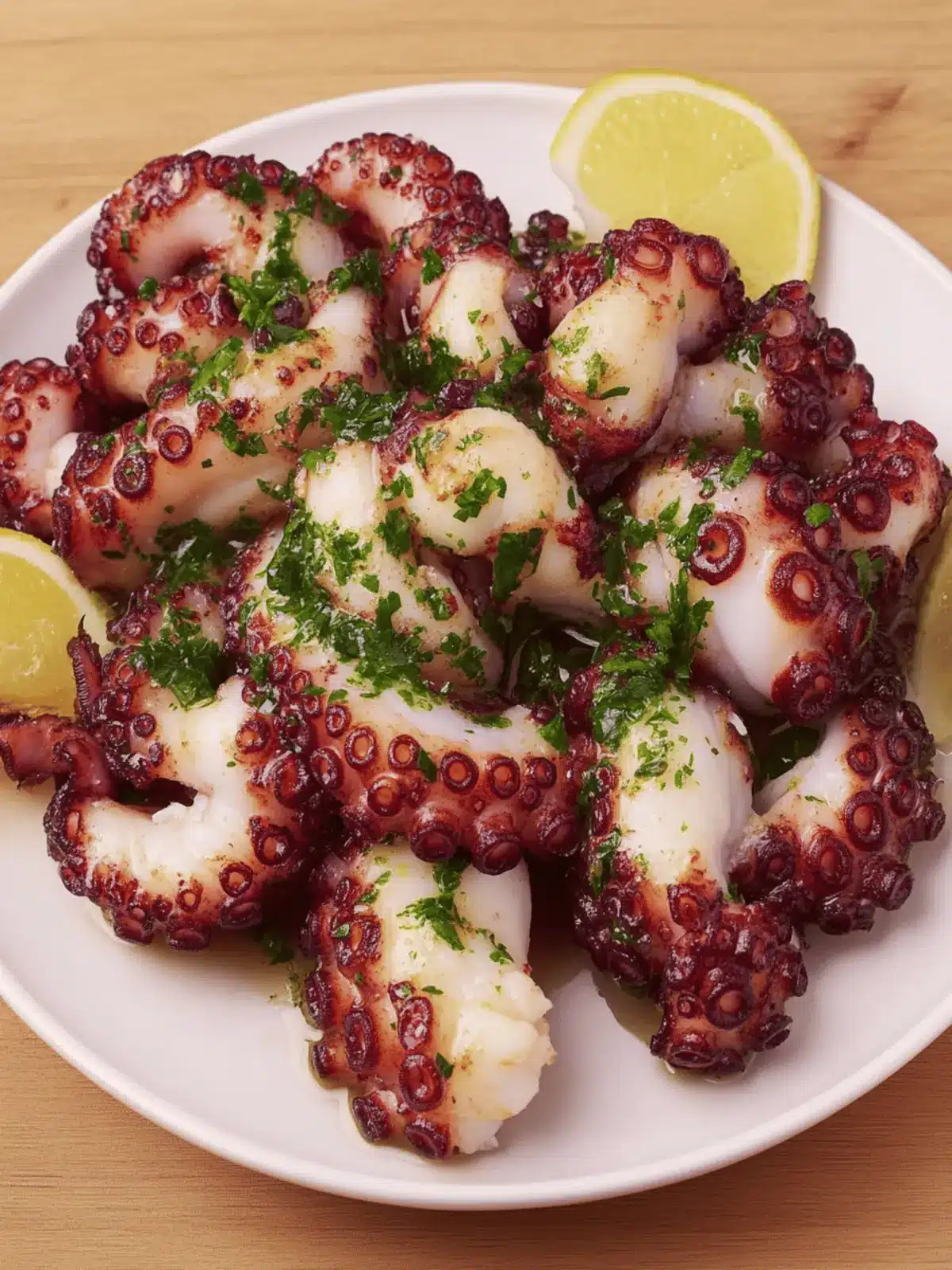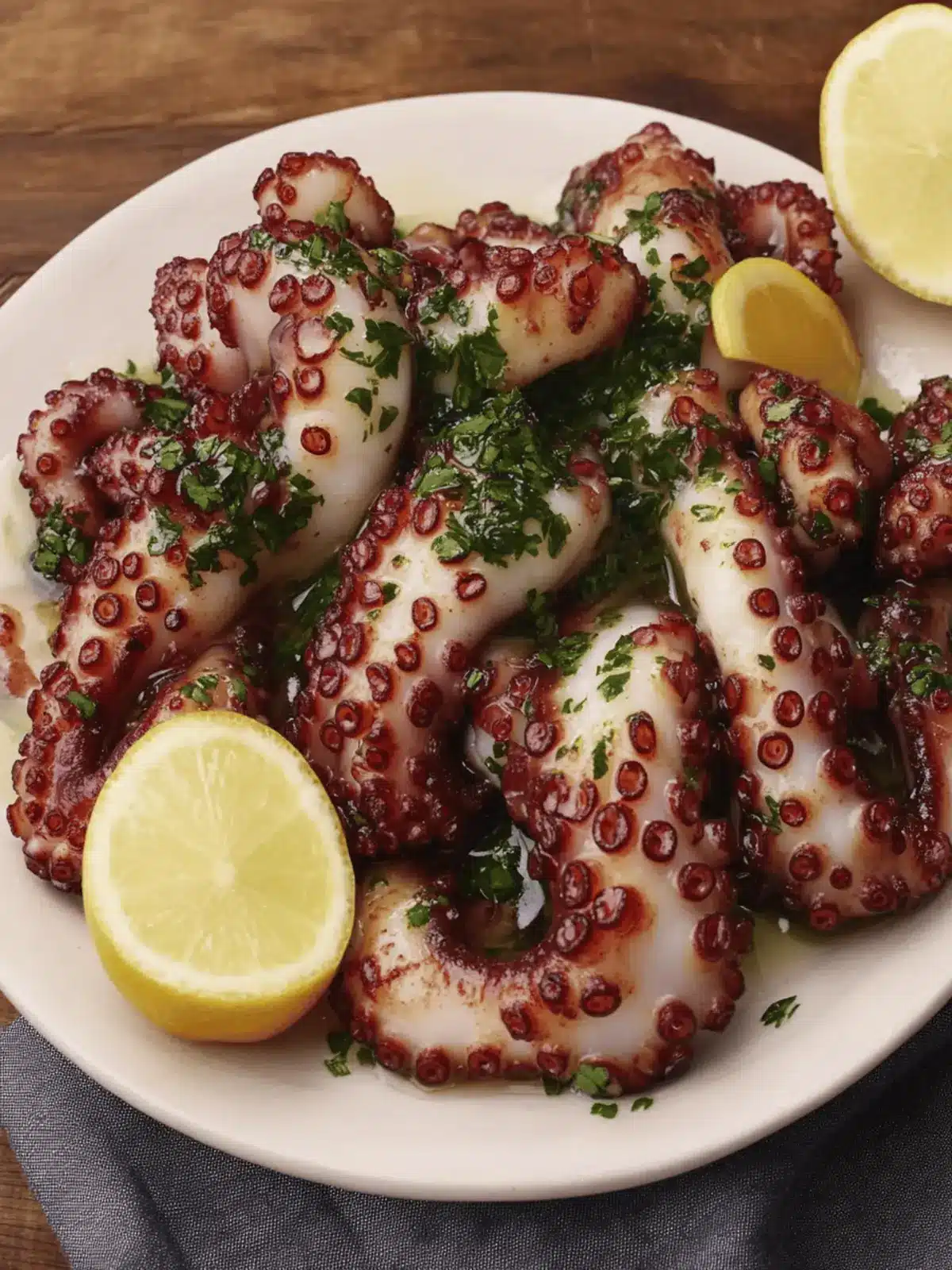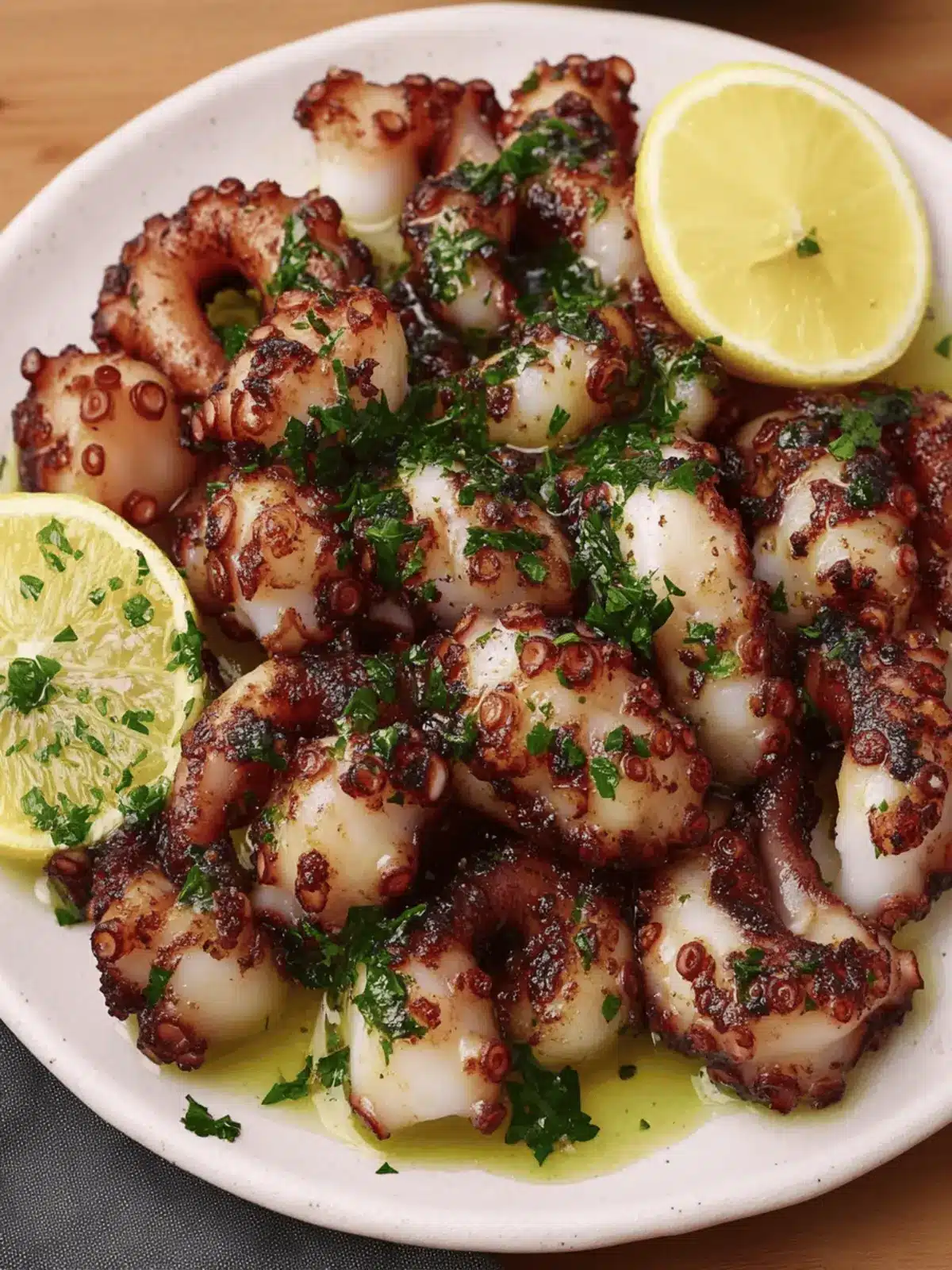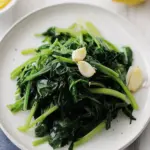Every time I step into the kitchen with a fresh octopus in hand, an exhilarating mix of anticipation and curiosity fills the air. The first time I prepared Boiled Octopus, I could hardly contain my excitement; I was about to unlock a flavor that transports you straight to the Mediterranean coast. The tender, succulent meat and the gentle hints of garlic and bay leaves promise a culinary experience that is both extraordinary and surprisingly simple.
This dish is ideal for anyone looking to break away from the mundane routine of fast food, offering a delightful and sustainable option that impresses guests yet requires minimal effort. With just a few ingredients and a little love, the transformation of the octopus into a culinary masterpiece becomes your reality. Whether you’re a seasoned chef or a home cook eager for something new, this Boiled Octopus recipe invites you to embrace a gourmet dish without the fuss. Grab your tongs and let’s make a meal that beckons you back to the table!
Why is Boiled Octopus so special?
Tender and Flavorful: This boiled octopus recipe brings out the natural sweetness of the meat, delivering a melt-in-your-mouth experience that’s hard to resist.
Simplicity: Just a handful of ingredients work together effortlessly, making it a perfect choice for both novice cooks and seasoned chefs.
Versatile Serving Options: Enjoy it warm with olive oil, lemon, or even as a salad topping; it beautifully adapts to any meal or occasion.
Impressive Presentation: The vibrant color and elegant slices will wow your dinner guests, making it a showstopper on any table.
Healthy Choice: Packed with protein and low in calories, it’s a nutritious alternative to fast food that satisfies cravings without the guilt.
Try pairing it with some roasted vegetables or a light pasta for a well-rounded meal that feels indulgent yet wholesome!
Boiled Octopus Ingredients
For the Octopus
• 1 whole octopus (2.5 to 3 pounds) – Make sure it’s cleaned properly, with the beak and eyes removed for the best flavor.
For the Broth
• 8 cups of water – This serves as the base for boiling and infusing flavor into your octopus.
• 1 medium yellow onion, halved – Adds a subtle sweetness and aroma during cooking.
• 3 garlic cloves, smashed – Infuses the broth with a rich, savory essence that complements the octopus beautifully.
• 2 bay leaves – These leaves impart a fragrant earthiness that enhances the overall flavor profile.
• 1 teaspoon black peppercorns – Offers a hint of warmth and spice to the dish.
• 2 tablespoons red wine vinegar or white wine – Elevates the taste with a touch of acidity, enhancing the natural sweetness of the octopus.
• 1 teaspoon salt – Essential for seasoning and balancing the flavors.
Optional Aromatics
• 1 small celery stalk – For extra flavor depth, this aromatic can subtly enhance the broth.
• A few parsley stems – These add a fresh note and a pop of color when served.
Your journey to creating the perfect boiled octopus begins with these simple ingredients; each one plays a significant role in delivering that delectable experience you’re craving!
How to Make Boiled Octopus
-
Rinse the octopus under cold running water to ensure it’s clean. Gently pat it dry with a towel, paying extra attention to ensure the beak and eyes are removed for a better taste.
-
Combine the water, onion, garlic, bay leaves, peppercorns, vinegar (or wine), and salt in a large pot. Stir well, then bring this lovely mixture to a boil over medium-high heat.
-
Add optional aromatics if you choose to use them. Once boiling, reduce the heat to a gentle simmer; this low and slow method will help achieve that perfect tenderness.
-
Lower the octopus into the pot using tongs. Cover loosely and let it simmer gently for 45 to 60 minutes, or until the tentacles are tender and easily pierced with a fork.
-
Turn off the heat and allow the octopus to rest in the broth for an extra 10 minutes. This resting time infuses the meat with even more flavor! Then, remove it from the pot, slice, and serve drizzled with olive oil and a squeeze of fresh lemon.
Optional: Garnish with fresh parsley for an aromatic touch.
Exact quantities are listed in the recipe card below.
Boiled Octopus Variations
Feel free to explore your creativity and tailor this dish to suit your palate.
-
Spicy Twist: Add crushed red pepper flakes or sliced chili peppers to the broth for a delightful kick. Spice up your experience and take your guests on a flavor adventure!
-
Citrus Zing: Incorporate the zest of a lemon or orange into the cook broth, heightening the overall flavor profile with a refreshing citrus note. This small step can transform the dish into a bright culinary delight.
-
Mediterranean Flair: Toss in olives and capers to the serving dish for a tangy and savory punch that reflects classic Mediterranean ingredients. Together with olive oil, it creates a beautiful harmony of tastes.
-
Savory Herbs: Experiment with fresh herbs like dill or tarragon to infuse the broth, giving the octopus an aromatic lift. These herbs can add depth and complexity to every bite!
-
Hearty Addition: Serve the boiled octopus atop a bed of sautéed spinach or with roasted potatoes for a filling meal. This adds texture and turns the dish into a hearty feast.
-
Vegan Option: Swap the octopus for large mushrooms like portobello to create a plant-based alternative. The cooking method remains the same, offering a satisfying and rich dish that even meat-lovers will enjoy.
-
Light Salad: Slice the octopus thinly and toss it with mixed greens, tomatoes, and light vinaigrette for a refreshing salad option. Perfect for those warm days when you crave something light yet satisfying.
-
Asian Inspired: Drizzle soy sauce or sesame oil on the cooked octopus, and garnish with scallions and sesame seeds for an enchanting twist. This fusion creates a delightful flavor experience that transports you to new culinary realms!
Expert Tips for Boiled Octopus
Clear Water: Ensure the water is clean and free from impurities before boiling. This enhances the flavor and quality of your boiled octopus.
Watch the Time: Avoid overcooking! Aim for 45 to 60 minutes; test for tenderness with a fork. Overcooked octopus can become chewy and tough.
Resting Matters: Letting the boiled octopus rest in the broth for 10 minutes enhances its flavor and tenderness, making the final dish much more delicious.
Serve Fresh: Pair the boiled octopus with fresh ingredients like olive oil and lemon to elevate its taste. Avoid heavy sauces that could overwhelm the subtle flavors.
Explore Variations: Experiment by adding different herbs or spices to the broth. This can give your boiled octopus a unique twist, enhancing its deliciousness further.
Make Ahead Options
Preparing Boiled Octopus in advance is a fantastic way to save time during busy weeknights! You can clean and store the octopus up to 24 hours in advance; simply place it in an airtight container in the refrigerator to keep it fresh. The broth can also be made a day ahead; just combine the water, onion, garlic, bay leaves, peppercorns, vinegar, and salt, then refrigerate it until you’re ready to cook. When it’s time to finish your dish, bring the broth back to a boil, add the octopus, and simmer as instructed. This way, you’ll enjoy restaurant-quality Boiled Octopus with minimal effort and maximum flavor!
What to Serve with Boiled Octopus?
Creating a delightful meal around tender, succulent octopus can take your dining experience to a whole new level.
-
Garlic Butter Pasta: This light pasta dish complements the octopus beautifully, offering a creamy texture that enhances its flavors while adding a comforting touch.
-
Crispy Roasted Potatoes: The crispy exterior and soft interior of roasted potatoes provide a delightful contrast to the gentle texture of the octopus. Tossed with herbs, they create a memorable harmony on your plate.
-
Arugula Salad: A fresh arugula salad with a squeeze of lemon offers a peppery crunch that balances well with the succulent meat. The bright flavors help cleanse the palate between bites of octopus.
-
Sautéed Spinach: Lightly sautéed spinach with garlic is both nutritious and vibrant, giving the meal a fresh pop of color and taste that works excellently together with the octopus.
-
Chickpea Salad: Tossed with cucumber, red onion, and a splash of olive oil, this hearty salad provides a satisfying bite and a hint of Mediterranean flair that pairs perfectly with the octopus.
-
White Wine: A crisp, chilled white wine like Sauvignon Blanc or Vermentino will elevate your meal, as its acidity beautifully complements the flavors of the octopus and enhances the overall dining experience.
-
Lemon Sorbet: For dessert, a refreshing lemon sorbet cleanses the palate and provides a light finish, making it an ideal way to conclude your gourmet meal with a sweet, citrusy note.
How to Store and Freeze Boiled Octopus
Fridge: Store leftover boiled octopus in an airtight container for up to 3 days. Keeping it sealed helps maintain its flavor and tenderness.
Freezer: If you want to keep it longer, freeze boiled octopus in portions wrapped tightly in plastic wrap and then in foil for up to 3 months.
Reheating: To reheat, thaw overnight in the fridge and gently warm it in a skillet with a splash of olive oil, ensuring it doesn’t dry out.
Before Storing: Allow the octopus to cool completely before placing it in the fridge or freezer to prevent condensation and maintain quality.
Boiled Octopus Recipe FAQs
How do I choose a fresh octopus?
Absolutely! When selecting an octopus, look for one that has a mild, ocean-like scent, and shiny, moist skin. Avoid any with dark spots or an off-putting smell. Fresh octopus should feel firm to the touch and have a vibrant color.
How should I store leftover boiled octopus?
To store your leftover boiled octopus, simply place it in an airtight container in the refrigerator for up to 3 days. This method keeps it tender and flavorful. Be sure to let the octopus cool completely before sealing it, as this helps prevent moisture build-up inside the container.
Can I freeze boiled octopus?
Very much so! If you’d like to freeze boiled octopus, first let it cool completely. Then, wrap it tightly in plastic wrap, followed by a layer of aluminum foil. This prevents freezer burn. You can store the wrapped octopus in the freezer for up to 3 months. For best results, thaw overnight in the fridge before reheating.
What should I do if my boiled octopus is tough?
If your boiled octopus turns out tough, don’t worry! This can happen if it’s overcooked or not cooked long enough. To fix this, try simmering it in broth again on low heat for another 20-30 minutes until tender. Making sure to rest the octopus in the liquid after cooking can help maintain its tenderness for next time.
Is boiled octopus safe for pets?
In general, boiled octopus is safe for dogs, but it should be given in moderation. Avoid any seasoning or sauces, as they may not be safe for pets. Always consult with your vet if you’re unsure about introducing new foods into your pet’s diet.
Can I use other seasonings for boiling octopus?
Absolutely! Feel free to experiment with herbs and spices that tickle your taste buds. Cumin, paprika, or even a bit of lemon zest can be lovely additions to the broth. Just maintain the same simmering method for best results, allowing those flavors to meld beautifully into the octopus.
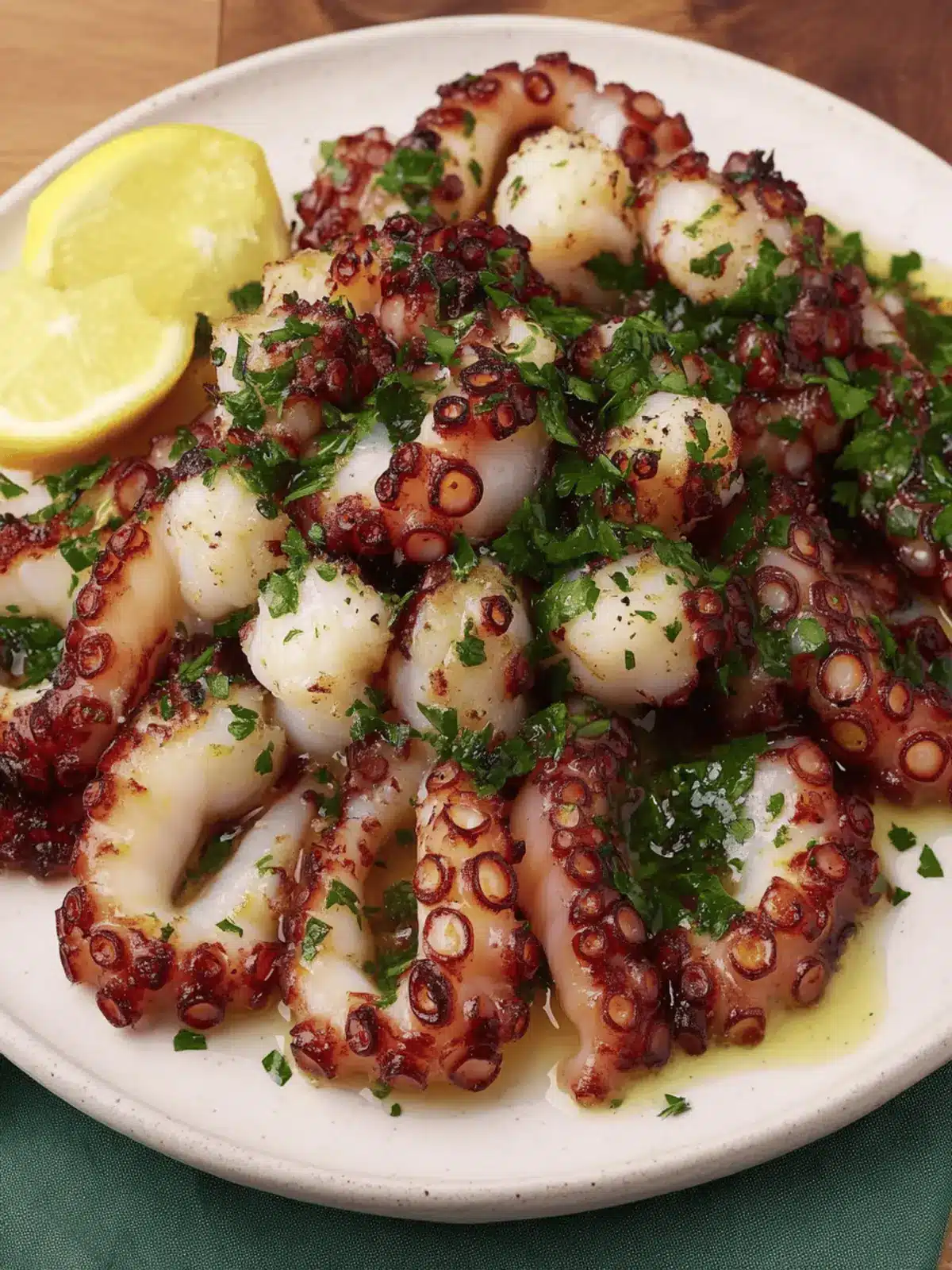
Perfectly Tender Boiled Octopus Recipe You Need to Try
Ingredients
Equipment
Method
- Rinse the octopus under cold running water to ensure it’s clean. Gently pat it dry with a towel, paying extra attention to ensure the beak and eyes are removed for a better taste.
- Combine the water, onion, garlic, bay leaves, peppercorns, vinegar (or wine), and salt in a large pot. Stir well, then bring this lovely mixture to a boil over medium-high heat.
- Add optional aromatics if you choose to use them. Once boiling, reduce the heat to a gentle simmer.
- Lower the octopus into the pot using tongs. Cover loosely and let it simmer gently for 45 to 60 minutes, or until the tentacles are tender and easily pierced with a fork.
- Turn off the heat and allow the octopus to rest in the broth for an extra 10 minutes. Then, remove it from the pot, slice, and serve drizzled with olive oil and a squeeze of fresh lemon.
- Optional: Garnish with fresh parsley for an aromatic touch.

